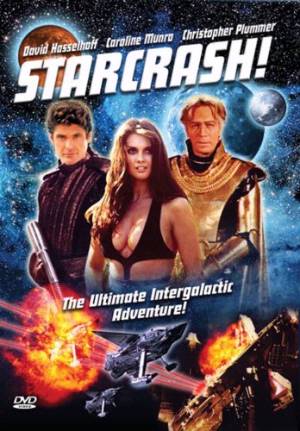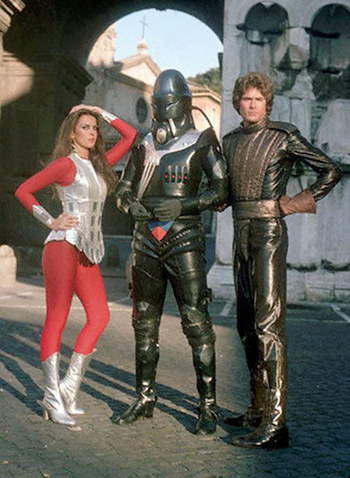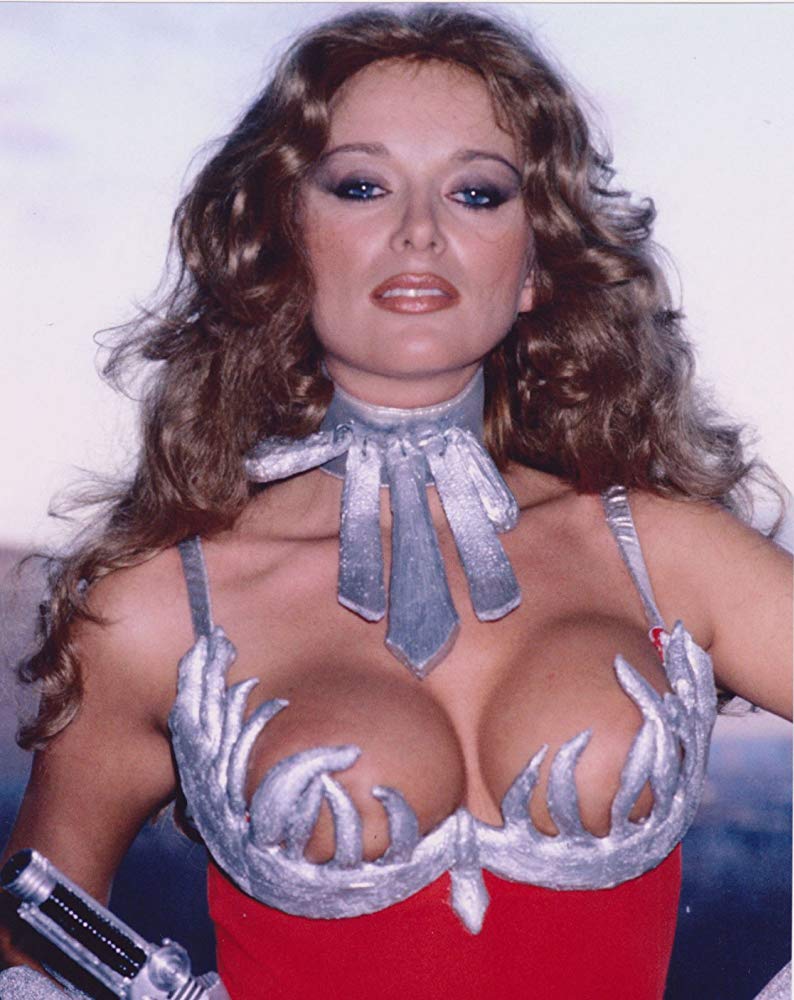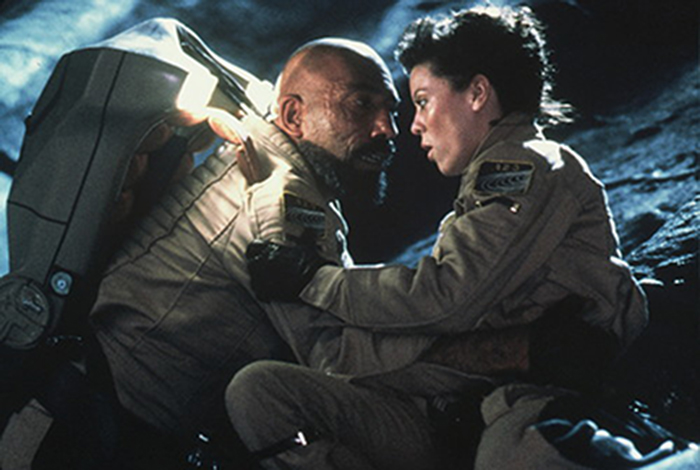|
|||||||||||||||||
November 2009 Web Edition Issue #3 |
|||||||||||||||||
| Mondo Cult Forum Blog News Mondo Girl Letters Photo Galleries Archives Back Issues Books Contact Us Features Film Index Interviews Legal Links Music Staff |
 L-R: David Hasselhoff, Caroline Munro and Christopher Plummer star in Roger Corman's STARCRASH Prospero’s SpellA Trilogy from Cormanand aBird-walk to Shakespeareby Lucas ParisRoger William Corman, simply put, is a prolific and influential figure in cinema. With 415 producer credits (presently), 56 director credits, 38 acting credits, and nine writing credits, to call him an auteur would be an understatement, to describe him as a film industry unto himself would be more accurate. A mere glance at his entry on IMDB is bewildering if not overwhelming. The monikers of “The Pope of Pop Cinema” and “King of The Bs” are not exaggerations; Roger Corman’s career spans approximately six and a half decades if one counts his first script sold in 1953 (The House In The Sea) which became 1954’s Highway Dragnet, directed by Nathan Juran (The 7th Voyage of Sinbad, 1958) with screenwriters Herb Meadow (The Lone Ranger, 1956) and Jerome Odlum (The Fast And The Furious, 1954, original script also by Corman) adapting the screenplay. Out of this vast tableau of film, three specific ones come to the fore. Starcrash (1978), Battle Beyond The Stars (1980), and Galaxy Of Terror (1981). From this trilogy of cult gems released one after the other each successive year (Starcrash was released State side by Corman’s New World Pictures in '79) one finds derivative strings linking to more famous works, but miss the exact influential work re-rendered, or how the works drawn from were, in fact, derivative in and of themselves. These three movies are more than mere clones capitalizing off of then present successes at the box office. Though they do borrow atmosphere, ape SFX techniques, and at times shot composition, they stand on their own (story wise) as fun interstellar romps that are in fact creative as well as imaginative. Starting with Starcrash is not only the most logical choice, but easily the most fun. Time and opinion on Starcrash being a mix of both kind and cruel, it has developed a cult following, was ranked number 48 out of 50 of the greatest sci-fi films of the '70s by Rolling Stone, and in a backhanded pat on the back of sorts, the puppet driven sleaze film skewer fest known as MST3K gave it a verbal roasting on one of its recent seasons, introducing the film anew to the Millennial crowd. Conversely, Googling up a review of the film by professional or amateur critic alike will produce largely negative results; criticism of its production values, editing, story, acting and how it is an imitation of Star Wars, abound. Yet, Starcrash is not fugazi Star Wars. Yes, it purloins several easily recognizable shots from the Death Star trench run segment of the stellar space opera from 1977, if not surprisingly faithful in how it recreates them, but it doesn’t plot the same story, nor does it try and resemble its universe wholly. Yes there are light sabers, but no cosmic mysticism that anyone can learn. There are huge ships with massive thrusters, swarms of fighters, a super powerful death weapon that the villains possess, but the villains are in rebellion against a benevolent tyranny ruled by a time stopping Emperor (Christopher Plummer), unlike George Lucas’ "galaxy far, far away" where a struggling rebel faction under the command of an imperiled princess fight against an asthmatic six foot six cyborg samurai at the helm of a planet destroying space station.  Caroline Munro, Judd Hamilton and David Hasselhoff Akira Kurosawa’s Hidden Fortress was the pull for George Lucas’ seminal space adventure script, and it was the novelization of his galactic fairy tale that would conjure up the Starcrash script. Penned by Luigi Cozzi (credited as Lewis Coates) when approached by producer Nat Wachsberger. Cozzi had never seen Star Wars but owned a copy of the novelization of the film, constructing his own script after reading it. The result is something that is less in the image of Episode IV, and more that of "Playboy meets Metal Hurlant" crammed into a blender with a liberal dose of Flash Gordon. Stella Star (the luscious Caroline Munro, see The Spy Who Loved Me, 1977) is a smuggler with enigmatic partner in crime, Akton (Marjoe Gortner). These two are pursued by space police officers Chief Thor (Robert Tessier), and robot Elle (Judd Hamilton in the suit, Hamilton Camp voicing an exquisite southern drawl) until they do a jump to hyper space, happening upon an escape launch when they come out that is from an imperial reconnaissance vessel destroyed prior to the opening credits roll. Taken into custody by the space police, and enduring a short incarceration, Stella and Akton are brought to the Emperor (aforementioned Christopher Plummer) and given a mission to find the remaining launches from the recon mission, hopefully ascertaining the whereabouts of evil Count Zartharn (Joe Spinell), his super weapon hidden in an unknown planet, and the Emperor’s son, Prince Simon (a baby faced David Hasselhoff). Through the course of the adventure, Stella and Elle hit the surface of a slew of exotic planets, encountering scantly clad amazons and their equally scantly attired queen (vulpine Nadia Cassini) on the first world before being chased off and narrowly escaping a stop motion guardian in the image of a topless woman; betrayed on the second world by Chief Thor who leaves them to freeze to death on an icy surface that predates Hoth by several years, only to be saved by Elle’s intricate systems—and Akton turning the ship around after dispatching Thor personally. Thae to the third where barbaric creatures dismantle Elle and attempt to cook Stella before Prince Simon arrives for a second save of the protagonist. This all leads to a climax where Akton battles stop motion golems to his victory and subsequent death, the Emperor stopping time inexplicably, and Stella Star with a rebuilt Elle at her side crashing a big-ass spacial construct that puts an end to Zartharn and his evil league. If that sounds hectic, and a bit like a Sinbad film with all the exploring and questing going on, it should. Luigi Cozzi loved Ray Harryhausen and wanted a sci-fi Sinbad film, envisioning “Sinbad on Mars” or “Sinbad Goes To Space” initially. Cozzi at the helm (also under the name Lewis Coates) managed to capture the wanderlust and madcap elements in the Sinbad films and beautifully incorporated them into Starcrash. Setting a ship among the stars instead of the seas—and putting one of the most gorgeous heroines to ever grace the silver screen before the eyes of American audiences to boot. The set was also eventful; Munro and Hasselhoff did most of their own stunt work, Hasselhoff accidentally knocking out the tooth of a stuntman apparently, first day on. Both he and Munro were plagued with gastric issues as well, Hasselhoff’s from food poisoning specifically, leading to sequences where a stunt man in a mask stood in for him since he could not perform. Furthermore, Marjoe Gortner and Robert Tessier improvised martial arts choreography for their lethal showdown. The result of all of this effort is a colorful, bright and dazzling sojourn through chaos—but it’s entertaining chaos with Caroline Munro’s Stella Star (and her outfits) being more than worth the expense of time. High camp, true, but worthy to revel in with alcoholic beverages and good company.  Sybil Danning (Can't you just SEE the Joe Jusko Painting... Moving on to the next year, and next decade with Battle Beyond The Stars, we come face to face with Akira Kurosawa again, and John Sturges. Produced by Corman with a $2,000,000 budget, this celestial remake of The Magnificent Seven (1960) homages the source material that John Sturges pulled from to make his classic western, Seven Samurai (Kurosawa, 1954), with a planet named Akir, and its inhabitants called Akirans. Robert Vaughn, having acted in The Magnificent Seven, stars in this film as well, playing the hardened killer for hire, Gelt. Vaughn had worked with Corman before in Teenage Caveman (1958) acting in the lead role, what he brought to the set of Battle Beyond The Stars was an experienced execution to his character, adding depth, darkness, sincerity, and sympathy. The film became Corman’s greatest fiscal success with an $11,000,000 coup. The straight forward story of Shad (Richard Thomas), an Akiran farm boy leaving his planet on a spaceship (that looks like a pair of supple breasts) in order to find help in fending off Sador (John Saxon) and his fleet (manned by brutish mutants) has an inexorable momentum and sense of discovery, but draws close to the plot structures of both films that preceded it. Corman, loving bare, curvy flesh in his camera lenses, certainly didn’t disappoint with the buxom Sybil Danning (Grindhouse, 2007, Werewolf Women of the SS segment) cast as St. Exim, an eye popping cross between a viking sailor and a jet fighter pilot. TV showings of the film were often censored, having a super-imposed panel added into Danning’s cockpit scenes to cover up the ample amounts of cleavage her revealing costume exposed, but sex appeal aside, it’s Danning’s uninhibited performance here as a sultry space warrior seeking glory and death that makes the character both memorable and endearing. Other notable performances are George Peppard (The A-Team, 1983) as “Cowboy”, Sam Jaffe as Dr. Hephaestus, and as one of several Nestors, Earl Boen (Terminator, 1984). In regards to Terminator, James Cameron was working on Battle Beyond The Stars as an effects photographer, and met Gale Anne Hurd who was working on the film as an assistant production manager. The two would work together with Cameron directing, Hurd producing and both of them writing to create the influential franchise, launching Schwarzenegger into his golden age of action movie greatness (not that the Conan films didn’t help Arnold a little with that). Following in 1981 was Galaxy of Terror, and the infamous worm monster scene. With the curvaceous Taaffe O’Connell (and her body double) aside, we have something very wonderful in this film that is often missed upon viewing. We have a new rendition of Forbidden Planet—not an “Alien Rip-off”. The plot structures are near enough to be relatives by blood, just minus Leslie Nielsen (The Naked Gun series) and Robbie the Robot. Sure the ominous, brooding darkness of Ridley Scott’s chest popping horror-scape can be found in Galaxy of Terror, but the premise itself, like Forbidden Planet’s, is William Shakespeare’s The Tempest. A ship and its crew ends up stranded on mysterious, strange grounds with a sort of magic at work around them that casts spells. In the case of Forbidden Planet and Galaxy of Terror, the spells are illusions of the mind most lethal, made flesh as they are imagined. In all three cases, the source of the illusion is either repelling the unworthy, or elevating the protagonist through the merit of his faculties.  Sid Haig being manhandled by the always spectacular Grace Zabriskie Edward Albert portrays Cabren, an officer aboard The Quest, a ship headed on a rescue mission where the commanding officers, Captain Trantor (Grace Zabriskie), Commander Ilvar (Bernard Behrens), and Baelon (Zalman King) get picked off by psychic nightmares turned into horrific reality along with the rest of the crew. The empathic Alluma (Erin Moran, Happy Days, and Joanie Loves Chachi) dismembered by cables come to life, the steady and quiet Quuhod (Sid Haig, The Devil’s Rejects, 2005) killed by his weapon of choice, crystal darts, Cos (Jack Blessing) to an imagined creepy-crawly creature, and Dameia (previously mentioned Taaffe O’Connell) via forced, and sustained intimacy with a worm monster. Only Cabren, Ranger (Robert Englund prior to his Elm Street fame), and Kore (veteran actor Ray Walston of The Sting, 1973) being the sole survivors of the mission, where [spoilers] it is discovered that Kore manipulated the situation with his mind, being a powerful psionic entity looking to pass on his power to Cabren, thus serving as Prospero, Caliban, and Sycorax all rolled into one. Produced by Corman at an estimated cost of $700,000, the film was fiscally successful even if it wasn’t critically, and like most of Corman’s fair, has grown a cult following around it over time, namely due to Taaffe O’Connel’s scene with the worm, which was a last minute inspiration on Corman’s part; loving Freudian concepts, and apparently phallic imagery, it just had to be a worm monster. God bless him for nothing if not a sideways, obscene sense of humor in crafting a scene that still evokes the train-wreck desire in audiences to keep watching in spite of wanting to look away. Through this trinity of Bs we see a trail of breadcrumbs linking other films, directors, and a legendary playwright together. In the case of Shakespeare and his last solo work, The Tempest, we are witness to a symbolic final bow, but find a thread spanning centuries from it; the fantastic concept of magic. Something coming out of thin air itself, summoned from the very ether, arcane forces or cognitive powers, of the imagination, these “Tempests” show that Shakespeare never really took a final bow after his 1610-1611 play dropped the curtain. The imagination of the mind is the most potent magic—Prospero’s magic. A spell which continues to be cast with eternal relevancy from antiquity, transcending eras and generations to the modern age. | ||||||||||||||||




